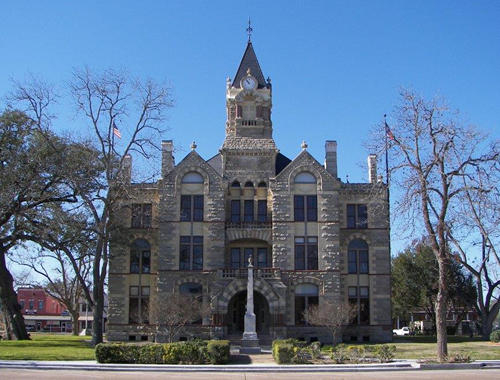Fayette County Courthouse, La Grange Texas. (original) (raw)
THE LOVE SONG OF J. RIELY GORDON
A series of photo essays of courthouses designed by J.R.G.
Fayette County Courthouse
before Restoration in 2004
Text and Photos by John TroesserBook Hotel Here > La Grange Hotels
 Fayette County Courthouse Tower Fayette County Courthouse Tower |
County and Seat La Grange is the county seat of Fayette County. The name comes from the Marquis de Lafayette's estate in France which translates as "The Meadows". After the (American) Revolution, it seemed that America couldn't name enough towns after the Marquis - and many of them remain today. At last count there were something like 16 towns across the United States named directly or indirectly after the Frenchman. Since there was already a Fayetteville in Fayette County - the citizens here settled for La Grange. |
|---|
Fayette is one of the most historic counties in the state of Texas. The Muster Oak - or Dawson Oak - on the NE corner of the square attests to that. The tree is looking much better than it has in years past - despite the fact that a good deal of its trunk is now concrete. Special attention has been given to the tree - and it's paid off.
A fire has recently (2000) destroyed a historic corner in downtown La Grange - but this will be made right - count on it. The square itself dates back to a time before a standard driving pattern existed for small towns across Texas. Please pay attention to the flow of traffic around the square when you visit - and watch the cars that are parked in between two traffic lanes. Corner intersections are NOT all four way stops.
The Building:
The understated Fayette County courthouse is not one of Gordon's "wedding cake" efforts like Waxahachie or Waco. It's a relatively utilitarian building - as it was designed to be. The detail is there - it just doesn't hit you at first glance.
Gordon often employed a cruciform floor plan (on his courthouses with a square floor plan) that drew air up through the entrances and staircases through a central shaft. It must have been a blessing to civil servants before air-conditioning.
For an informative no-nonsense description of the courthouse - we turn to Richard Zelade's Hill Country:
"The most visually arresting building on the square is, of course, the Fayette County Courthouse, built in 1891 to the tune of $96,000. The finished product was well worth the cost, don't you agree?
The exterior walls are Belton white limestone, complemented with blue sandstone quarried at nearby Muldoon. Red Pecos sandstone stringcourses (decorative horizontal mouldings) and pink Burnet granite columns and steps form rich accents. At the base of the clock tower is a large stone slab on which is carved a large American eagle. Above this, at the tower's four corners, are carved griffins. The roof is covered with slate and Spanish tile."
Part II - The Clock / Bell Tower
The bell tower can be reached from a small staircase off the third floor. The door leading to the stairs is locked with a hasp and padlock. The steps are small and the place is definitely not for claustrophobics. Tiny windows look down at the sidewalk - nearly 100 feet below.
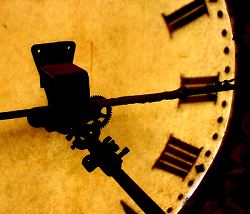 |
|---|
| The back of the West facing clockface |
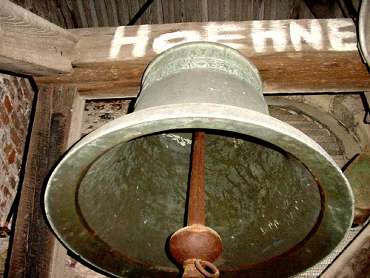 |
|---|
| Looking up at the bell |
On the way up one sees that someone named Albert was once in the tower with white paint and time on his hands. It can't immediately be proven that Albert was a county employee - but when he painted his name here - he was certainly "on the clock".
The Bell
Above the bell (which could use a little Brasso, by the way) one sees what is presumably Albert's surname.
We found three Hoeners in the La Grange phone directory - but we didn't want to squeal on Albert.
 |
|---|
| The cherub-encrusted bell - cast in Louisville, Kentucky |
 |
|---|
| The clapper and the iron rope ring |
Looking up - is the bell and the huge clapper collared with an iron rope ring. The bell is now struck by an electric hammer - visible in another photo
The Clockworks
Tiny 8-inch square steps with no railing or handhold brings one to the clockworks.
 |
|---|
| The courhouse clock mechanism |
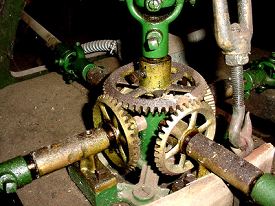 |
|---|
| The four-way drive mechanism |
 |
|---|
| Another view of the clock mechanism |
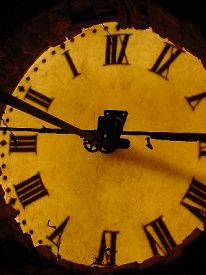 |
|---|
| The reversed numerals - Does anybody really know what time it is? |
The four clock faces - with reversed numerals give off a rich amber glow even during the day (if you happen to be inside). At night it appears faint and ghostly - perfect for Halloween.
The Weathervane
The height and shape of the tower guarantee a breeze - even when the tree branches outside (and far below) are stock-still.
 |
|---|
| The clock tower weathervane |
The 100-foot-tall clock tower has a slate shingle roof and is capped by a weathervane with an intricate but hard to determine design.
The courthouse at one time had a spacious atrium that had been replaced by a large vault. Only one photograph exists of the atrium - an impromptu snapshot showing banana trees, a fountain and a resident squirrel perched on the judge's shoulder. We were told the atrium will be included in the restoration.
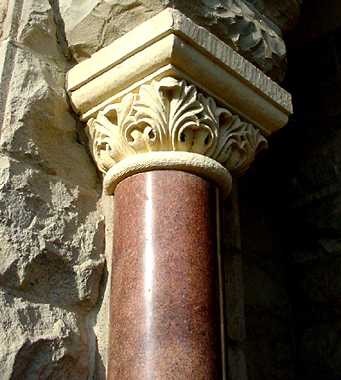 |
|---|
| Several of Gordon's trademark features are immediately recognizable - Corinthian column close-up view |
 |
|---|
| One of the more intricate details |
The Obelisk
Approaching the main entrance to the building - is an obelisk in memory of the Fayette County men who were killed with Captain Nicholas Mosby Dawson at Salado Creek - just outside of San Antonio in 1842.
The middle initial of Dawson was misspelled - and so a correction was made - with the word (correction) cut into the stone.
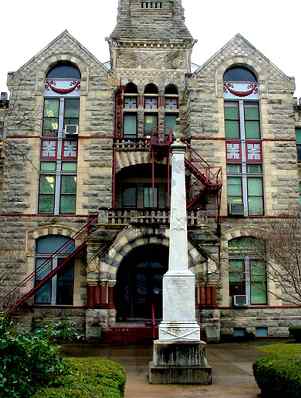 |
|---|
| The Main Entrance |
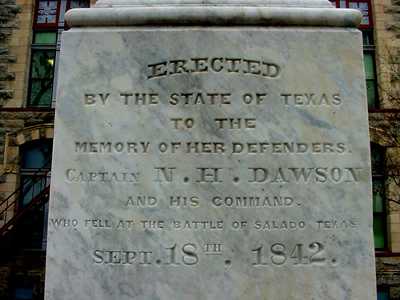 |
|---|
| The inscription on the obelisk |
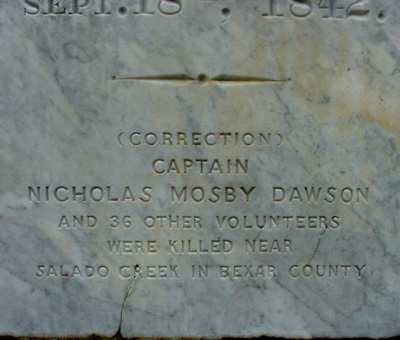 |
|---|
| The Correction - a stonecutter's worst nightmare |
Architectural Details
Entering the door - you're greeted by 8 short Corinthian columns - similar to Gonzales, Lee, and Comal County courthouses. Looking up is an American eagle composed of three large sandstone slabs - an unusual detail.
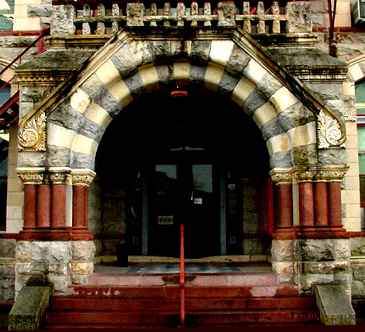 |
|---|
| The main entrance |
 |
|---|
| Sandstone American Eagles |
Stonework
You will also see a checkerboard effect worked into the outside wall with alternating light and dark stone. This theme is repeated in the pattern of the marble floor.
The darker stone is "Muldoon Blue" sandstone - quarried in Muldoon, Texas.
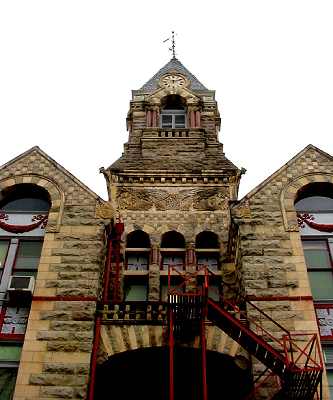 |
|---|
| The alternating light and dark stonework |
Cornerstone
Although the description of the courthouse mentions Pecos red sandstone - you'll have to look hard to find it. Here it can be seen near the cornerstone. Gordon employed it as sparingly here as he used it generously in the Bexar County courthouse.
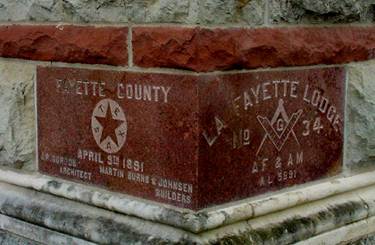 |
|---|
| The cornerstone of Fayette County Courthouse |
Gargoyles
The courthouse has two gargoyles that don't look as frightening as they look frightened. Judging by the look on their faces - they have a fear of heights. We asked if they had names - but were told that they were as yet unnamed. Perhaps La Grange will have a Name-the-Gargoyle contest during the restoration.
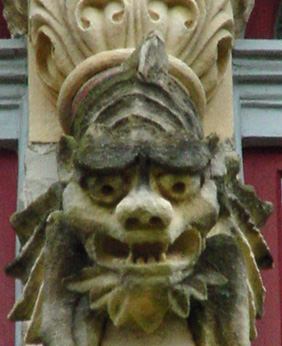 |
|---|
| "Quasi" - The Acrophobic Gargoyle (north side) |
 |
|---|
| The gargoyle's view of the courthouse lawn |
 |
|---|
| The courtroom |
Entering the building from the main entrance - you'll immediately see a vault in front of you when you enter.
This was where an atrium once held semi-tropical plants year-round and provided sanctuary for at least one squirrel.
 |
|---|
| A portion of the checker-board marble floor. |
The floor is marble in the same light and dark checkerboard pattern as the exterior walls. The marble thresholds bear the imprint of none other than "The Father of the Texas Granite Industry" himself - Frank Teich.
 |
|---|
| Sculptor and Granite expert - Frank Teich's company imprint. |
When the light strikes the transom window of the former County Sheriff's office - one can see where T. L. Flortnoy's painted name has been razor-bladed off the glass.
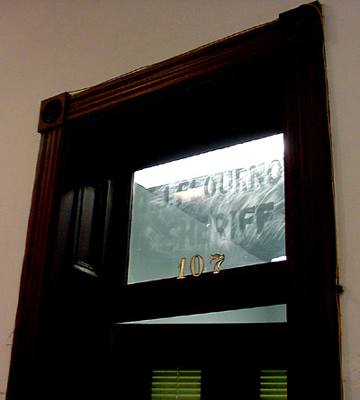 |
|---|
| A transom window |
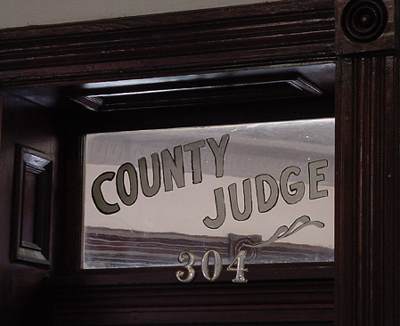 |
|---|
| County judge's door |
The courtroom was used (very) briefly for the 1996 movie Michael.The movie company furnished the courtroom with a set of engraved or engraved-looking prints of the Presidents of United States to add to the room's already stately dignity.
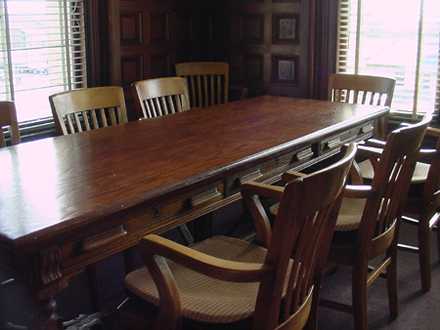 |
|---|
| The Jury table |
| Off from the main courtroom - a few feet behind the jury box is the deliberation room. At least one early photograph shows the courtroom with the judge's bench inexplicably under the balcony. It gave the judge something to look at beside lawyers - but made it hard on the audience to watch the proceedings. |  |
|---|---|
| The Jury room | |

Custom Search
